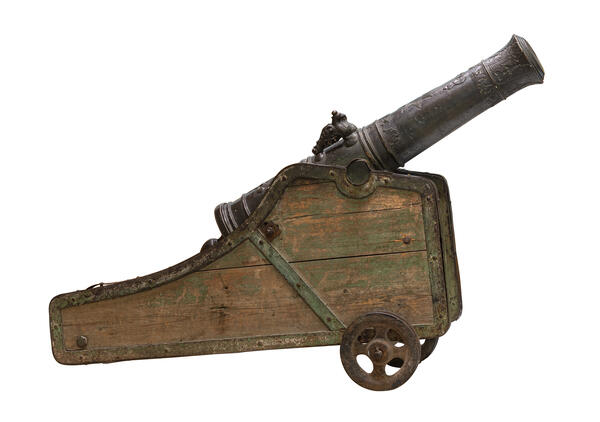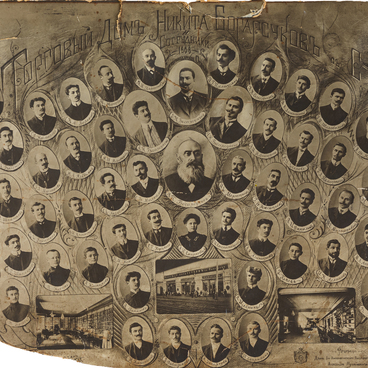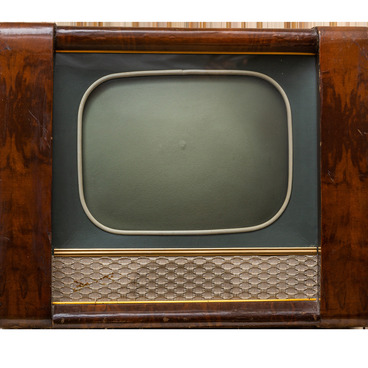‘The arms and armament supplies’ collection displays a bronze three-pound cannon of 1732. Prince Grigory Potemkin-Tavrichesky gave the cannon as a gift to the Black Sea Cossack Host on behalf of Catherine the Great.
The cannon was cast at St. Petersburg Arsenal plant in 1732, during the reign of Anna Ivanovna. The three-pound cannon was named as such, because of its caliber, which, at that time, was measured by the cast iron ball weight. The artillery pound was equal to 490 grams, that is, the three-pound cannon shell weighed 1.47 kilograms.
The gun barrel’s inner diameter is 76.2-mm. The eight-pointed star of the Order of St. Andrew the Apostle the First-Called and the State Emblem of the Russian Empire (a double-headed eagle with the coat of arms and imperial monogram on the chest) are depicted on its outer surface. An acanthus ornament, symbolizing the triumph, is depicted around the muzzle.
The St. Andrew’s Star was usually depicted on the cannons belonging to the Guards Infantry Regiments: the Star was considered an Imperial Guard symbol since the time of Peter the Great. By order of October 22, 1788, Grigory Potemkin approved the Star as the emblem of the Black Sea Cossack Host and the motto ‘For faith and fidelity’. It is likely that this slogan was associated with the original name of the Cossack formation — the ‘Faithful Black Sea Cossacks Host’. They were opposed to the ‘infidels’, those who joined the Ottoman Empire side and settled therein.
The cannon from the Historical and Archaeological Museum collection is mentioned in the documents describing the funeral of Zakhary Chepega, the Black Sea Cossack Host second ataman, who held this position after Sidor Bely. The cannon was carried behind his coffin. Thereafter, the cannon was kept on the last surviving bastion of the Ekaterinograd fortress, which had already been left abandoned by that time. By cannon shots, the citizens were advised that it was noon.
At the beginning of the twentieth century, the cannon was placed near the ataman palace. For the purpose thereof, a new wooden carriage was made for the cannon, since the old one had been lost. The cannon was kept at this place up to 1942 until the day when the Kuban was occupied by German troops. It was decided to blow up all large facilities in the city, including the palace so that the enemies would be unable to use them. The cannon survived, and shortly thereafter, it was donated to the museum.
The cannon was cast at St. Petersburg Arsenal plant in 1732, during the reign of Anna Ivanovna. The three-pound cannon was named as such, because of its caliber, which, at that time, was measured by the cast iron ball weight. The artillery pound was equal to 490 grams, that is, the three-pound cannon shell weighed 1.47 kilograms.
The gun barrel’s inner diameter is 76.2-mm. The eight-pointed star of the Order of St. Andrew the Apostle the First-Called and the State Emblem of the Russian Empire (a double-headed eagle with the coat of arms and imperial monogram on the chest) are depicted on its outer surface. An acanthus ornament, symbolizing the triumph, is depicted around the muzzle.
The St. Andrew’s Star was usually depicted on the cannons belonging to the Guards Infantry Regiments: the Star was considered an Imperial Guard symbol since the time of Peter the Great. By order of October 22, 1788, Grigory Potemkin approved the Star as the emblem of the Black Sea Cossack Host and the motto ‘For faith and fidelity’. It is likely that this slogan was associated with the original name of the Cossack formation — the ‘Faithful Black Sea Cossacks Host’. They were opposed to the ‘infidels’, those who joined the Ottoman Empire side and settled therein.
The cannon from the Historical and Archaeological Museum collection is mentioned in the documents describing the funeral of Zakhary Chepega, the Black Sea Cossack Host second ataman, who held this position after Sidor Bely. The cannon was carried behind his coffin. Thereafter, the cannon was kept on the last surviving bastion of the Ekaterinograd fortress, which had already been left abandoned by that time. By cannon shots, the citizens were advised that it was noon.
At the beginning of the twentieth century, the cannon was placed near the ataman palace. For the purpose thereof, a new wooden carriage was made for the cannon, since the old one had been lost. The cannon was kept at this place up to 1942 until the day when the Kuban was occupied by German troops. It was decided to blow up all large facilities in the city, including the palace so that the enemies would be unable to use them. The cannon survived, and shortly thereafter, it was donated to the museum.



